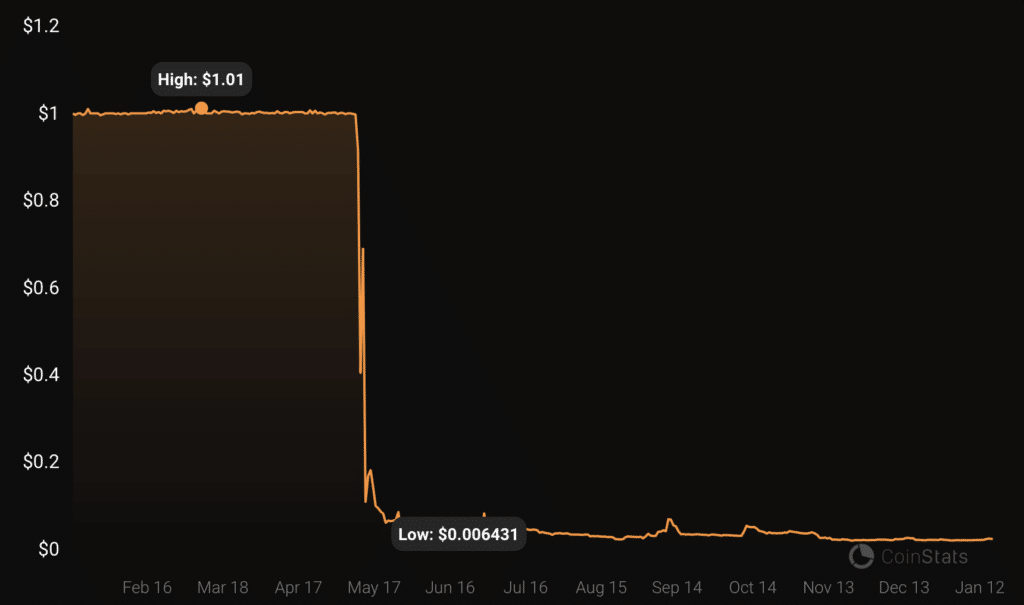DeFi might have bright future in 2023 while NFTs need to prove their value, experts say

Since the start of 2022, the crypto markets have gone down from the $3 trillion mark — which was recorded in November 2021 — to $2.2 trillion in January last year, to roughly $800 billion at the start of 2023.
These unfavorable conditions have triggered a bearish atmosphere surrounding all decentralized finance (DeFi)-related sectors, including play-to-earn (P2E) games and decentralized autonomous organizations (DAOs). The non-fungible token (NFT) industry was not spared in the onslaught, as several NFT projects initially worth millions of dollars declined to near-zero values.
Despite the damaging effects of the past fiascos, several market watchers have reason to believe that these events were necessary to purge out weak projects, leaving the strong to thrive in an industry already plagued by attacks from regulatory agencies and governments alike.
The Terra collapse
One of the most referenced debacles of last year was the Terra Collapse that happened in May and precipitated a wave of insolvency crises into the crypto scene, leading to the implosion of a crypto lender Celsius Network and hedge fund Three Arrows Capital.
The fall of the Terra ecosystem was majorly triggered by the depegging of TerraUSD (UST) in early May.

Terraform Labs had taken out $150 million worth of UST from a decentralized exchange 3pool on May 7, looking to meet liquidity demands on other exchanges. However, two traders, who looked to exploit a vulnerability witnessed, swapped 185M UST for USDC on 3pool, destabilizing TerraUSD’s peg in the process.
Terraform Labs had to take out another 100 million UST from 3pool in an attempt to balance UST’s ratio to other stablecoins on the exchange, but the damage had already been done.
All subsequent moves aimed at re-pegging the uncollateralized algorithmic stablecoin proved futile, leading to a cascade of failures that eventually impacted the entire ecosystem as market-wide selloffs ensued, triggered by investors’ dread.
The aftereffects of the Terra implosion were catastrophic at best.
One of crypto’s largest hedge funds with $10B under asset management, Three Arrows Capital (3AC) fell a month later, partly due to massive exposure to Terra. According to founders Su Zhu and Kyle Davies, the hedge fund lost $500 million in the Terra collapse. The 3AC collapse led to liquidity issues for several entities within the scene, including Babel Finance, Voyager, and BlockFi. These entities were revealed to have been substantially exposed to 3AC.
The FTX implosion
Following a market-wide crash in May, the crypto scene staged a minor comeback that recovered some of the losses of the previous months, but the sudden FTX implosion in November sealed the bear’s hold over the markets.
Bitcoin (BTC), Ethereum (ETH), and other assets plummeted to record lows amid a prevalent capitulation phase. Investors’ confidence in centralized exchanges declined.
The FTX saga began with a CoinDesk article about the firm’s liquidity.
Binance founder and CEO Changpeng Zhao (CZ) announced on Nov. 6 that the exchange would be liquidating all its FTT token holdings as a result of reports suggesting insolvency issues. This led to a sharp decline in FTT’s value, leading to selloffs and a mass withdrawal of funds from FTX, as investors feared it was the next crypto entity to implode.
The bank run eventually exposed FTX’s liquidity crisis. FTX founder and CEO Sam Bankman-Fried (SBF) had to reach out to CZ for a bailout from Binance. Binance had agreed to bail out FTX on Nov. 8, announcing it would purchase the trading platform, but CZ noted that the exchange could pull out of the deal at any time. Binance eventually did pull out following a due diligence process on FTX’s sheets.
This raised greater concerns about just how bad the FTX situation is.
Following a series of damning revelations, FTX eventually filed for Chapter 11 bankruptcy at a US Bankruptcy Court on Nov. 11, with SBF stepping down as CEO. Attorney John J. Ray took charge to handle the company’s bankruptcy proceedings.
Several entities were affected by the FTX collapse due to significant exposures to the exchange. Some of these include BlockFi which paused withdrawals on Nov. 11, and Galois Capital with a $100 million exposure to FTX, Galaxy Digital, CoinShares, Nexo and several others.
More recently, crypto lender and Digital Currency Group subsidiary Genesis paused withdrawals on Nov. 16, citing the impact of the FTX collapse. Genesis’ move affected the crypto exchange Gemini and its Earn program, as the exchange revealed a $900 million exposure to Gemini.
Crypto hacks
Amid the debacles, liquidity crises, and the collapse of the crypto markets, the cryptocurrency industry also experienced numerous hacks in 2022.
The top 10 hacks in the industry resulted in losses to the tune of $2.1 billion. Notably, the largest crypto hack in 2022 was the Ronin Bridge hack in March, which saw a loss of $612 million.
Amid the FTX saga, the company suffered an exploit that saw the hackers move $477 million from the platform. Reports suggest the hack was an inside job. Additionally, the Wormhole Bridge and the Nomad token bridge were separately hacked for $321 million and $190 million, respectively.
Furthermore, market maker Wintermute was exploited last September and lost $160 million. A month later, a BNB Chain bridge was hacked for $100 million.
Crypto, DeFi, and NFTs in 2023
Several market observers believe the broader cryptocurrency scene will blossom in 2023 after going through one of its toughest phases in history last year. Others believe the past predicaments are necessary for the sanitation of the crypto scene, and the purge is likely to spill into 2023.
“2021 was a boom year for crypto, DeFi, and NFTs. 2022 was a bummer year. 2023 will be the year that the market and regulators clear out the riffraff,” said David Lesperance, an attorney with 30 years of experience and managing director at Lesperance & Associates.

According to him, the past events, while unfavorable, have given the industry an eye-opener, leading to demands for accountability and greater scrutiny. This should help in exposing bad industry players this year, he says.
The FTX saga tested investors’ confidence in centralized exchanges. Reports surfaced, suggesting that a blatant misappropriation of users’ funds led to the exchange’s collapse. This triggered demands for accountability, as other platforms, including Crypto.com and Binance, published proof-of-reserves reports amid an exodus of customers. A study last month revealed a growing number of users demanding proof-of-reserves reports.
“The tide is going out and the crypto world is about to find out who was swimming naked and who is wearing a bathing suit. Those found to be swimming naked will find themselves under close examination by regulators and criminal law enforcement in multiple jurisdictions to see if there were any chargeable transgressions,”
Lesperance remarked.
Law enforcement and financial regulators across several jurisdictions took a special interest in the crypto scene following the FTX debacle. The greater level of scrutiny is likely to contribute to the industry’s progress or downfall. Besides the FTX collapse, the Terra fiasco attracted attention from law enforcement, as South Korean prosecutors launched a manhunt for Terra founder Do Kwon. The country has also put the local cryptocurrency scene under greater scrutiny.
Notably, James Butterfill, head of research at digital asset investment firm CoinShares, claimed that the crypto scene will have to go through years of constant rebuilding to regain investors’ confidence, especially at the levels witnessed in 2021 and early 2022.
However, he believes the DeFi sector is likely to recover faster than the rest of the crypto industry, especially with evidence that smart contracts were effective in meeting the demands for which they were originally prepared.
“Rehypothecated debt has declined somewhat, but due to the nature of the smart contracts, it has not had the snowball effect that some feared; this suggested that investor confidence may recover more quickly,”
Butterfill said.
After the FTX collapse, how would regulators approach the industry?
The FTX fiasco underlined the need for greater oversight within the crypto scene for proper consumer protection measures.
The United States, which has seen a huge concentration of crypto investors, recently paid closer attention to the scene. The Department of Justice (DoJ) and the Securities and Exchange Commission (SEC) separately charged Sam Bankman-Fried with several crimes, including fraud, conspiracy and money laundering.
Senator Elizabeth Warren pushed a bipartisan bill looking to address crypto-related money laundering schemes shortly after the FTX fall.
Last month, crypto-friendly senator Pat Toomey introduced a bill to regulate stablecoin payments as one of his last moves before eventually retiring.
The US Senate Banking Committee Chair Sherrod Brown recently reiterated his desire to see the cryptocurrency industry cracked down following the FTX collapse. “There’s nothing ‘democratic’ or ‘transparent’ about a shady, diffuse network of online funny money,” Brown had said in June 2021. After the FTX debacle, he changed his stance.
Lesperance believes that regulators’ approach to overseeing the industry after the FTX implosion will help pave the way for further development.
“The US is leading the way, not only on FTX, but also the future regulation of other exchanges who wish to service US customers. You will find that regulators in other countries will follow the US in their approach to regulating those who cater to residents of their countries,”
“SEC chief Gary Gensler has already stated that he believes that existing US securities laws should be applied to the crypto world. For exchanges, this means not only full audits of assets and liabilities but also government examination to ensure proper KYC, AML, etc. regulations which are already applied to non-crypto exchanges,” he added.
The lawyer noted that the SEC will have to treat NFTs like every other security in order to properly regulate them. “This means properly filing and disclosure before being offered to US customers. Since almost all NFTs are offered to the general public rather than exclusively accredited Investors, you will see a significant number of current offerings disappear as they cannot meet the regulatory requirements….or cannot afford to comply,” Lesperance stated.
James Butterfill believes Europe’s MiCa regulatory framework is the best within the global scene and would be adopted by other regulatory agencies. “We expect much tougher regulation more in line with the existing banking to begin to be formulated and in part implemented this year, particularly for the on- and off-ramps for crypto,” Butterfill noted.
Liquidity expectations for 2023
Last year witnessed a series of liquidity crises that eventually led to the bankruptcy of several firms. FTX’s implosion, in particular, was triggered by a liquidity crunch caused by a massive bank run. Genesis recently paused withdrawals due to a liquidity crisis they are currently experiencing. Celsius also had to pause withdrawals due to dried-up liquidity.
Some proponents believe this issue is a necessary evil that will spill into 2023. “The correlation and intertwining of the crypto market were exposed in 2022. This will continue to unravel in 2023 as various exchanges, hedge funds, and other players in the crypto space trigger margin calls. The dominoes have not yet all fallen,” Lesperance commented.
Conversely, Butterfill believes that the crypto scene has only witnessed a shift in liquidity between assets and exchanges rather than a dry-up. He highlighted the sustenance of liquidity within the bitcoin market amongst its trading pairs, staying steady at $10 billion a day. “It simply shifted to other exchanges, with centralized exchange dominance being steadily eroded by decentralized ones and bilateral over-the-counter (OTC) arrangements where custody is far more secure,” Butterfill remarked.
Prospects for P2E games this year
Play-to-earn games attracted mass adoption in 2021 due to the bull run that resulted in exponentially higher values for digital assets and a corresponding massive espousal rate for the cryptocurrency industry. The bear market of 2022 flushed out several P2E enthusiasts, leading to a dearth of players. Notwithstanding, the industry remains one of the fastest growing within the crypto scene.
The P2E gaming industry reached a peak valuation of $116 billion in 2021. This was due to the mass adoption rate. Around 34% of the individuals that took a global survey revealed that they had played P2E games, with 29% being in Hong Kong, 27% in Spain, and 27% in the United Arab Emirates. Additionally, data suggests that 13.3% of men in the US had patronized P2E games.
Several P2E platforms that rose to prominence include Axie Infinity, Decentraland, STEPN, and CryptoKitties. Axie Infinity, in particular, at some point, was able to accommodate over 2 million active players on a monthly basis. But investors have also experienced issues with P2E platforms, including the collapsed CryptoZoo NFT project promoted by professional wrestler Logan Paul.
Lesperance believes these P2E platforms will have to prove that they are more beneficial than detrimental to investors in order to rack in players in 2023 due to the caution with which investors are entering the crypto scene right now.
Notably, Marc Arjoon, Research Associate at CoinShares, does not believe P2E platforms will attract massive adoption in Q1 2023.
“Either way, Axie Infinity and to a lesser extent immutable X were the main gaming platforms and saw their valuations rise in line with the bubble so, no, I don’t expect this.”
Arjoon remarked.
He believes these games require more time to be properly developed, and developers should leverage more scalable blockchains such as layer-2 or hybrid networks.
What about DAOs?
DAOs constitute the purest form of decentralization and are crucial in maintaining the concept, but due to inherent flaws noticed within their structures, mass adoption has declined.
Still, the global scene has had a gradual increase so far. As of August of last year, the number of active DAOs stands at a whopping 5,000 in number, having a cumulative treasury of $9.7 billion. DAOs have also been recognized by some jurisdictions, including three US states – Vermont in 2018, Wyoming in 2021, and Tennessee last year. But just how much growth will these organizations experience in 2023?
“DAOs come in two forms: incorporated or unincorporated. The problem with the latter is that in law, they are treated as general partnerships. In a general partnership, each member is liable for the DAOs actions and the actions of other members. If there is fraud or a hack or an accident, other members or third parties can sue a member with the deepest pockets,”
Lesperance disclosed, speaking on the future of DAOs.
He also highlighted a second problem that these organizations might have to overcome, which is in the form of taxation, “since a given DAO may have members from multiple jurisdictions, each requiring different tax and financial disclosure obligations,” he added. Lesperance also noted that American taxpayers are likely to dump their DAOs once they weigh the tax complexities and their filing obligations with the promises of the organizations.
Arjoon, on the other hand, believes some DAOs will perform better than others in 2023, noting that the ones that have a better vision and a more robust governance system are likely to succeed over others.
“DAOs that more closely integrate with real-world assets and regulations/laws will likely see easier acceptance.”
“There is also further experimentation to be done with dual governance structures like Optimism for example, but the infrastructure for these organizations (voting, multisig, management, payroll, etc.) will become even more important in 2023,” he concluded.
While it is difficult to accurately predict the trajectory of the crypto industry in 2023, there is hope for a better year than the previous one. Investors will be entering the scene with a more cautious outlook, and significant progress in properly regulating the industry will contribute to higher confidence.












